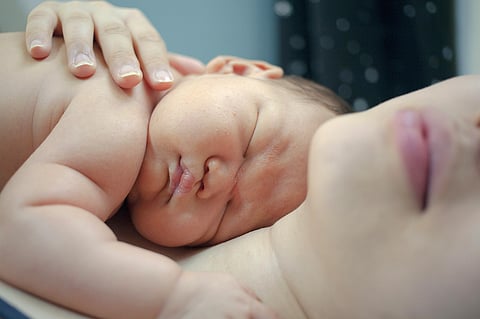1. Naevus flammeus, or stork bite/mark -Also known as salmon patch or macular stain, they are harmless collections of blood vessels that leave behind tiny, flat, rosy-red marks.
Often referred to as "stork bites," salmon patches are persistent lesions that develop at the back of the neck. However, as kids get older, they become less apparent and are readily covered by hair.
Salmon patches can also develop in the middle of the face, on the lip, in the eyelids, or on the forehead. These are commonly referred to as "angel's kisses" because they nearly invariably diminish as the child gets older. Treatment for salmon patches is rarely necessary.
2. Mongolian spots - They are bluish, irregular flat patches found mainly on the back and bottom, and are more common in Asian and African babies with dark skin colour.
They are benign and less noticeable as the child gets older. They could be mistaken for bruises.
3. Haemangioma of infancy - As many as 1 in 20 babies are affected by hemangiomas. Premature babies are more prone to get this kind of birthmark, and girls are three times more likely than males to have them. Strawberry hemangiomas and deep hemangiomas are the two most common types of hemangiomas.
The vivid red color of strawberry hemangiomas gives rise to their name. They might appear as elevated, hard pimples or as flat, splotchy patches on the skin's surface.
Strawberry hemangiomas may be more likely to ulcerate, or turn the birthmark's surface into an open sore, if they are situated next to a bodily opening or fold. Sometimes the hemangioma will flow pus or blood, which needs to be examined by a doctor.
Deep hemangiomas are elevated blue-gray lumps that develop in the skin's deeper layers. When this kind of birthmark first appears on the skin's surface, it could not be noticeable for several weeks or months after a baby is born.
Hemangiomas typically grow quickly in the first year of a baby's life. After that, they fade gradually and level off. By the time a child reaches the age of ten, many hemangiomas have entirely disappeared, while some may still cause slight skin discoloration or ripples.


